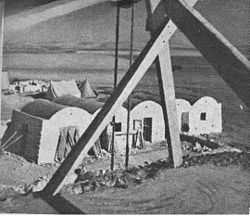Beit Eshel
| Beit Eshel | |
|---|---|
 | |
 Beit Eshel | |
| Coordinates: 31°14′06″N 34°48′46.48″E / 31.23500°N 34.8129111°ECoordinates: 31°14′06″N 34°48′46.48″E / 31.23500°N 34.8129111°E |
Beit Eshel (Hebrew: בֵּית אֵשֶׁל) was a Jewish settlement established in the Negev desert in Mandate Palestine in 1943 as one of the three lookouts, alongside Revivim and Gvulot. It was located two kilometres southeast of Beersheba.
According to the Jewish National Fund, the name means "House of the Tamarisk" and refers to the tamarisks planted by the patriarch Abraham at Beersheba. [1]
The pioneers of Beit Eshel were Holocaust survivors from Austria, Czechoslovakia, and Germany. [1] As one of three outposts, the residents of Beit Eshel were tasked with checking the viability of agriculture in the area based on climate analysis, availability of water, etc. In 1947 the village had a population of over 100. [1]
In May 1948, when Egypt invaded Israel in the early stages of the 1948 Arab–Israeli War, Beit Eshel was cut off from Jewish territory and was shelled heavily by the Egyptians. According to the Haganah, this attack was repulsed.[2] After 8 men and women were killed, many buildings destroyed or harmed and with the Egyptians continuing to fire at the village, the settlers left. The Egyptian army destroyed the remainder of Beit Eshel. In October 1948, Beit Eshel was liberated. However, the settlers who came back to Beit Eshel found only destruction, and decided to establish a new moshav named HaYogev in the Jezreel Valley.
In 1960, a group of Beersheva residents established a volunteer society to preserve Beit Eshel as a national heritage site.[3]
Archaeology
Excavations at Beit Eshel in 2003 by a joint team of the Israel Antiquities Authority and the Archaeological Division of Ben Gurion University of the Negev unearthed Ghassulian flint sickle blades from the fifth millennium BC, suggesting that the site was a Chalcolithic flint workshop.[4]
References
- ↑ 1.0 1.1 1.2 Jewish National Fund (1949). Jewish Villages in Israel. Jerusalem: Hamadpis Liphshitz Press. p. 17.
- ↑ Gene Currivan (May 22, 1948). "Air War Spreads". New York Times. p. 2.
- ↑ Stayput Beersheba
- ↑ The Ghassulian sickle blades workshop ofBeit Eshel, Beer Sheva, Israel
| ||||||||||||||||||